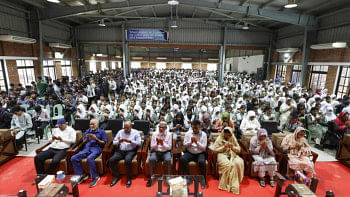Some pre-emptive measures to avoid the middle-income trap

Graduation from a low-income to a middle-income country has long been coming for Bangladesh as it has been performing extremely well among developing countries over the last few years. Robust economic growth supported by an export intensive industry and a burgeoning service sector has pushed the country into the limelight as a beacon of inspiration for most LDCs. While superficially the country might seem to be gliding along, internal deterrents like a lacklustre banking sector, high youth unemployment, lack of export diversification and the gradual deterioration of its agro-economy are dragging the country back.
But, focusing only on short term problems can sometimes blind a country from seeing the true problems ahead. And anticipating the bigger, more obstinate issue of falling into the "The Middle-Income Trap" is a possibility that Bangladesh is not entertaining.
Bangladesh has created for itself a self-sustained brand image in the global market as one of the finest apparel processors around today. Boasting around 5,000 factories and employing around 4 million people, mostly women, the RMG industry is one that is leading from the front in the quest for economic glory. Since the 1970's, the country's dependence on export has exponentially increased with RMG taking up 80 percent share of total exports. The RMG industry's success is highly dependent on cheap labour and quality processing, making it an attractive investment for foreign buyers, and propelling it into being the second largest exporter of clothing goods. But this feat is not unique to Bangladesh. This initial growth boom is a textbook example. Most developing countries have shared a fairly similar storyline; running past the low-income group only to be stuck at the middle-income bubble.
One of the primary criterions for graduation is a Gross National Income (GNI) per capita of USD 1,230 and Human Asset Index (HAI) of 66 or above. This quite strikingly indicates a considerable rise in the overall living standard of people. The minimum salary grade for RMG workers is currently set at Tk 8,000 per month or USD 4 a day, with more and more revisions of the provision coming up in the future. With each passing day, Bangladesh is gradually losing its core competency in cheap labour. This in turn is biting into the profitability of RMG manufacturers by raising Selling, General and Administrative expenses. With foreign buyers' reluctance to raise final retail prices, this has come up as a major concern for the RMG factories, forcing some of them to even incur losses.
Beyond that, poor port logistics and rising transportation costs have compelled some US and EU buyers to opt for nearshoring. So, lack of export diversification and over-reliance on the labour intensive RMG industry might come back to haunt Bangladesh, as has been the case for most middle-income trapped countries.
While the status of graduation is comparatively paramount, there are certain drawbacks that come with it. One such obstacle is losing preferential duty. Bangladesh currently enjoys duty free access to the EU market in accordance with the "Everything but Arms" initiative along with preferences in China and India. After graduation, Bangladesh will face 15.62 percent tariff on average in the EU along with the existing 10 percent in the US. This is likely to lose the country USD 2.7 billion in export earnings. Another impediment is ineligibility for concessional loans from the World Bank. All these, coupled with an unskilled labour population are likely to limit economic growth from 2024.
Now is a better time than any to wisen up in order to minimise the damage. The country should underline what adjustments it needs to make as well as derive empirical initiatives from similar stories.
Competitive edges are more often than not features that set you apart, and what better way to establish an advantage than through continuous innovation? Bangladesh sits on the lowest position in South Asia in terms of innovation along with consistently scoring low in ranked institutes, research papers and citations. One salvation in this regard is research and development. The country needs to make firms more research intensive through incentivising R&D expenses. And in order to draw in more private and public investment towards R&D.
The government along with the help of NGOs must also utilise foreign aid sitting idle in the pipeline to incorporate a culture of research in the educational institutes in the country in the form of upgraded labs, better instruments and more relevant facilities. Developed countries spend on average about 5 percent of their GDP on R&D. Expenditure of 1 percent of total GDP for Bangladesh should suffice for the next 5 years. Prioritising research is at the forefront of Malaysia's "New Economic Model" (NEM), formed to help the country graduate to a developed one.
Industrial Revolution 4.0 comes hand in hand with innovation. Dealing with the tech revolution to come is tricky for Bangladesh which has been raking in jobless growth over the last few years. Of the 109.1 million working age population, only 63.5 have been participating in the labour force, with Bangladesh having to cope with 2 million young people entering the market each year. With the introduction of AI, the RMG, leather and agro-processing industries would lose a further 5.4 million jobs in the future. But there is no way to circumvent this other than sustainably espousing the insurgency.
Sustainably striving through this change requires heavy investment in social capital. This would entail a core structural change in education as demonstrated by Malaysia formulating "The New Education Blueprint 2013-2025". An educational shift in primary, secondary and tertiary, focusing on training children from the start to be fluent in technology is a must to overcome economic myopia. Furthermore, encouraging a new generation of entrepreneurs through easier fundraising facilities like accessible financing instruments and start-up funding platforms should be undertaken. Another sector that needs dire attention is on the skills frontier. Currently, the mismatch in industry requirements and employee skills is being tackled by the government through the introduction of Industry Skills Councils (ISCs). But they are completely negligent in training people for future changes in skills requirements.
Only, through more strengthened cooperation among the private and public sector can the country hope to avoid the imminent problems that are to come. The country should immediately deploy resources in order to assess the impacts of the problems that come with graduation and form committees to articulate possible steps that should be implemented in order to avoid the "Middle-income trap".
Tahmeed Rifa is a business student currently studying at Bangladesh University of Professionals (BUP).





Comments